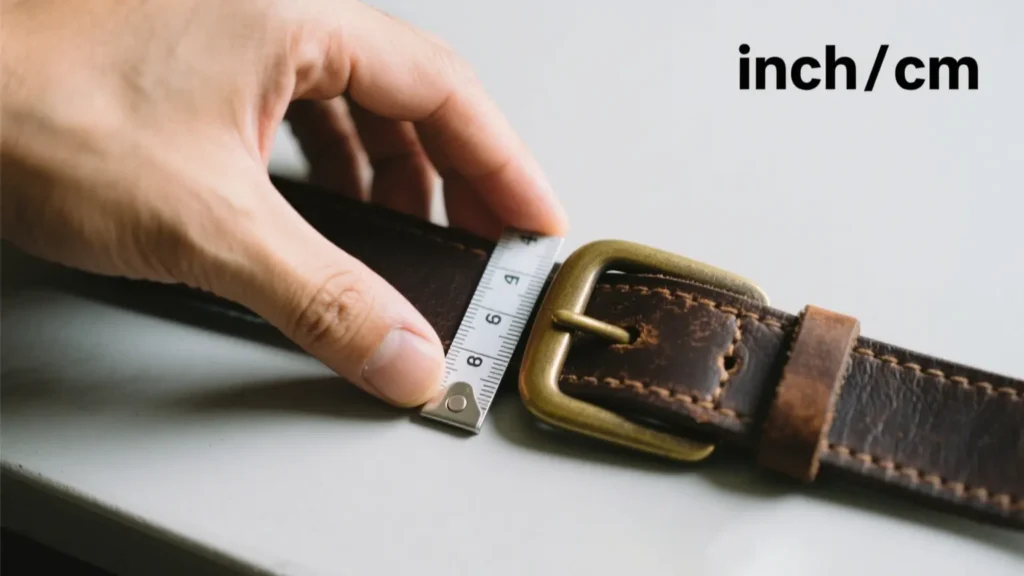Belt Sizes: Quick Answers (Inch↔CM, Widths, Ratchet)

Get straight, no-fluff answers to the most-searched questions about belt sizes—how to measure without a belt, US/EU conversions, widths for jeans vs suits, and how ratchet sizing works. Bookmark this page and use the quick navigation below.
Quick navigation: How to measure · US/EU conversion · Dress vs casual widths · Ratchet belts · Gift sizing · Women’s belt sizes · Kids’ sizes · Big & Tall · Center hole rule · Common mistakes
How do I measure belt size without guesswork?
Use one of three reliable methods:
- Best: Measure a belt you own from the buckle fold to the center hole—this distance is your belt size.
- Body method: Wrap a soft tape through your belt loops at the height you wear your pants; add about 2 inches / 5 cm.
- Pant-tag shortcut: Belt size ≈ pant size + 2 inches.
These methods land you on the center hole (most belts have 5 holes at 1 inch / 25 mm spacing) for adjustability either way.
What’s the quick US ↔ EU belt size conversion?
EU tags are in centimeters to the center hole. Handy pairs: 80 ≈ 32″, 85 ≈ 34″, 90 ≈ 36″, 95 ≈ 38″, 100 ≈ 40″, 105 ≈ 42″, 110 ≈ 44″, 115 ≈ 46″. When in doubt, divide the EU number by 2.54 cm per inch to get inches, then round to the nearest even US size.
Dress vs casual: which belt widths should I choose?
- Dress/suits: typically 30–35 mm (≈ 1.18–1.38″), fits slimmer trouser loops and looks cleaner.
- Casual/jeans: 38–45 mm (≈ 1.5–1.75″), fills wider denim loops and feels proportional.
Check loop limits before buying; forcing wide straps through narrow loops shortens effective fit and damages stitching.
How do ratchet belt sizes work?
Ratchet (track) belts use micro-adjusts—usually ¼” (≈ 6–7 mm) per click—with roughly 30–40 positions. Straps ship long and are trim-to-fit: try the belt first, cut in small steps, re-test, then lock the buckle. They’re great for weight fluctuation or layering because you always stay near a “center” of adjustability.
How do I pick a belt size as a gift if I don’t know the waist?
Check the recipient’s most-worn pant tag and add +2″. If between two sizes, go one size up (belts can be shortened; too-short can’t be fixed). Ratchet belts are a safe choice for flexibility. Include an easy exchange option to remove friction.
What should I know about women’s belt sizes?
Women’s belt sizing varies with waist height (natural waist vs high-rise vs low-rise). Measure where the belt will sit and convert inch↔cm as needed. Styling tips: slim belts (≤ 25–30 mm) for dresses/high-rise skirts; 30–35 mm for tailored pants; 38–40 mm for jeans. Browse style-specific picks here: Women’s Casual Belts – Women’s Casual Belts – Stylish Everyday Wear ; Women’s Dress Belts – Women’s Dress Belts – Elegant & Slim Styles
What about kids’ belt sizes?
Measure through loops and add ~1″ (2.5 cm) for growth. Many kids’ belts span ranges (e.g., 22–26″). Prefer extra holes or ratchet-style adjustability to cover growth spurts without frequent replacements.
Big & Tall—any special sizing rules?
Plan for daily variability. Choose pant +2–3″, prioritize straps with more holes or ratchet tracks, and ensure hardware is sturdy. Slightly wider straps (40–45 mm) distribute pressure better on denim and carry gear more comfortably.
Why does everyone mention the “center hole” rule?
Belts are designed so the tagged size lands on the middle hole. This centers the buckle visually and gives about two holes of play either way for seasonal layers, post-meal expansion, or minor weight changes. If you’re always on the first or last hole, the size is off.
The most common belt-size mistakes (and quick fixes)
- Buying the same number as the pant tag → add +2″.
- Measuring to the tip instead of buckle-fold-to-center-hole → re-measure.
- Ignoring belt width vs loop limits → check loops first.
- Trimming ratchet straps before a try-on → test, then cut in small increments.
- Using under-supportive belts for heavy EDC/work gear → size right and choose thicker leather or reinforced webbing.
Related guides & shopping
- For deep men’s charts, keep using your dedicated “Belt Sizes for Men” article so it ranks for the men-only intent.
- Looking for styles to match your size? Explore your shop navigation (e.g., Men’s Leather Belts, Women’s Casual Belts, Women’s Dress Belts, Ratchet Belts).
